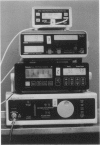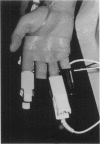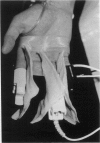Abstract
Pulse oximetry has been shown to be accurate under steady state conditions. In this study, the accuracy of four pulse oximeters are evaluated and compared during outpatient general anesthesia for third molar extractions. The oximeters evaluated are the Nellcor N-100, the Ohmeda 3700, the Novametrix model 500, and the Bird 4400 portable pulse oximeter.
Ultralight general anesthesia for oral surgery presents a unique challenge for respiratory monitoring in that patients are often not intubated and commonly experience periods of hyper- and hypoventilation. Airway obstruction, apnea, and laryngospasm may occur easily and patients often vocalize and move during surgery. Because hypoxemia is the primary cause of morbidity and mortality during anesthesia, an accurate, continuous, and noninvasive monitor of oxygenation is critical to risk management.
Twenty ASA class I and II patients underwent outpatient general anesthesia for third molar removal using nitrous oxide-oxygen, midazolam, fentanyl, and methohexital. Arterial blood samples were obtained at five-minute intervals during anesthesia, as well as any time a desaturation of >5% occurred, for measurement of arterial SaO2 with an IL282 CO-Oximeter. These values were compared with simultaneously recorded saturations observed for each pulse oximeter. A total of 122 arterial samples were obtained over a range of PaO2 from 52-323 mm Hg and observed saturations of 70-100%.
The Bird 4400 portable pulse oximeter proved to be the most accurate and reliably predicted arterial saturation under these conditions (y = 1.03x - 2.8, r = 0.85). The Novametrix model 500 pulse oximeter also demonstrated a high degree of accuracy by linear regression analysis, but displayed the lowest correlation coefficient (spread of data points) overall (y = 0.97x + 2.8, r = 0.80.) The Nellcor N-100 pulse oximeter also proved to be highly accurate. (y = 1.05x - 4.1, r = 0.84.) In contrast, regression analysis of the observed saturations obtained with the Ohmeda 3700 pulse oximeter revealed that this unit significantly underestimated arterial saturation (y = 1.20x - 19.6, r = 0.83.)
This study demonstrates that despite the rigorous conditions imposed by outpatient general anesthesia for oral surgery, three of the pulse oximeters tested were linearly accurate in predicting arterial oxyhemoglobin saturation over the range of 70-100%. The Ohmeda 3700 was found to significantly underestimate arterial saturation.
Full text
PDF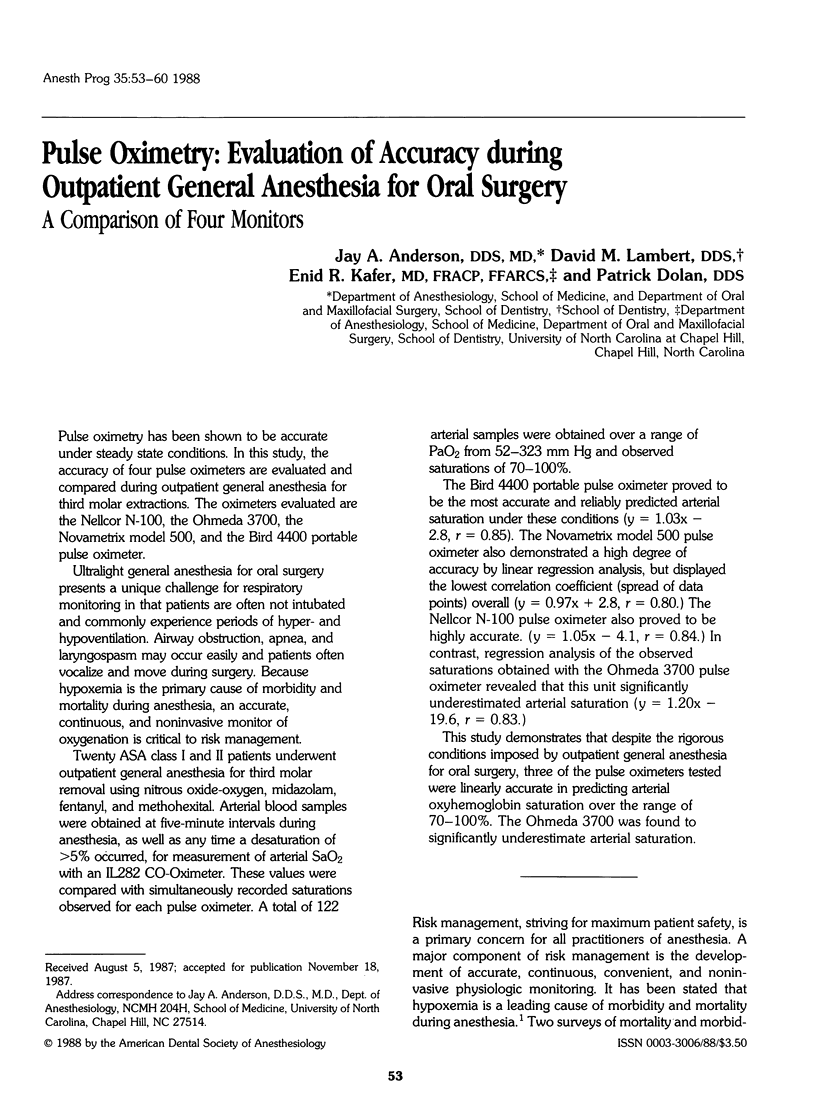
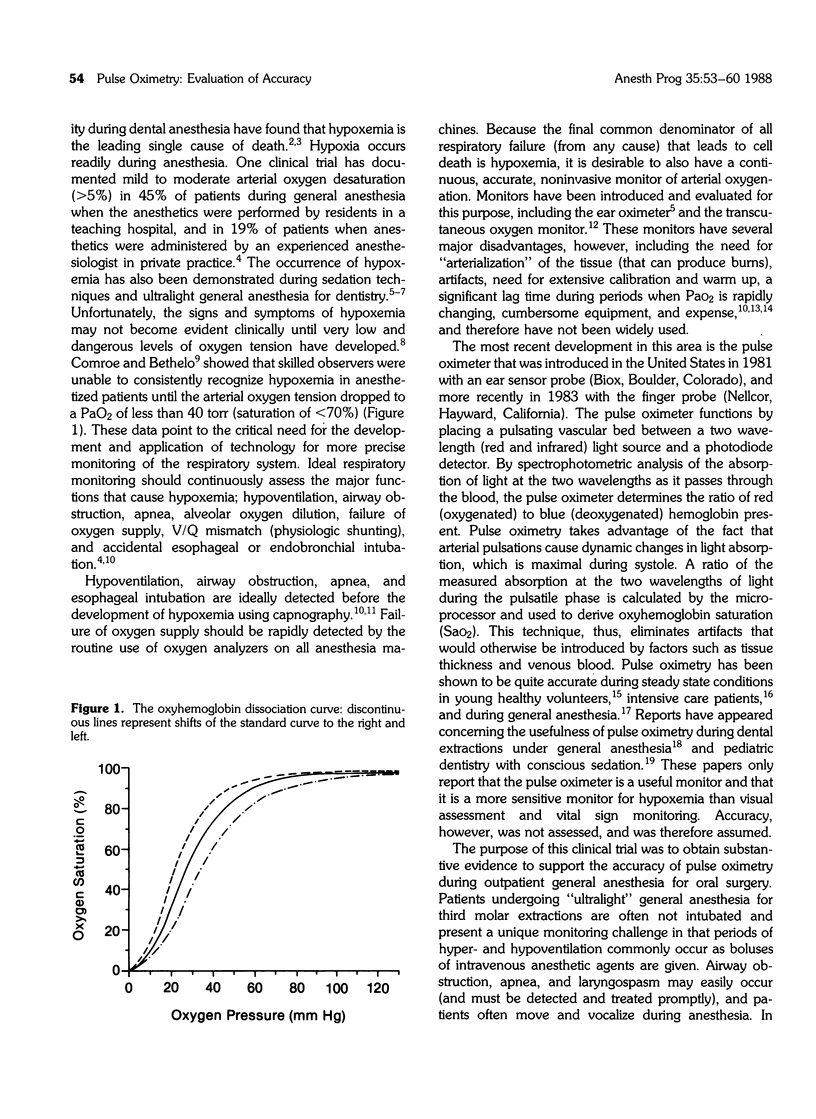
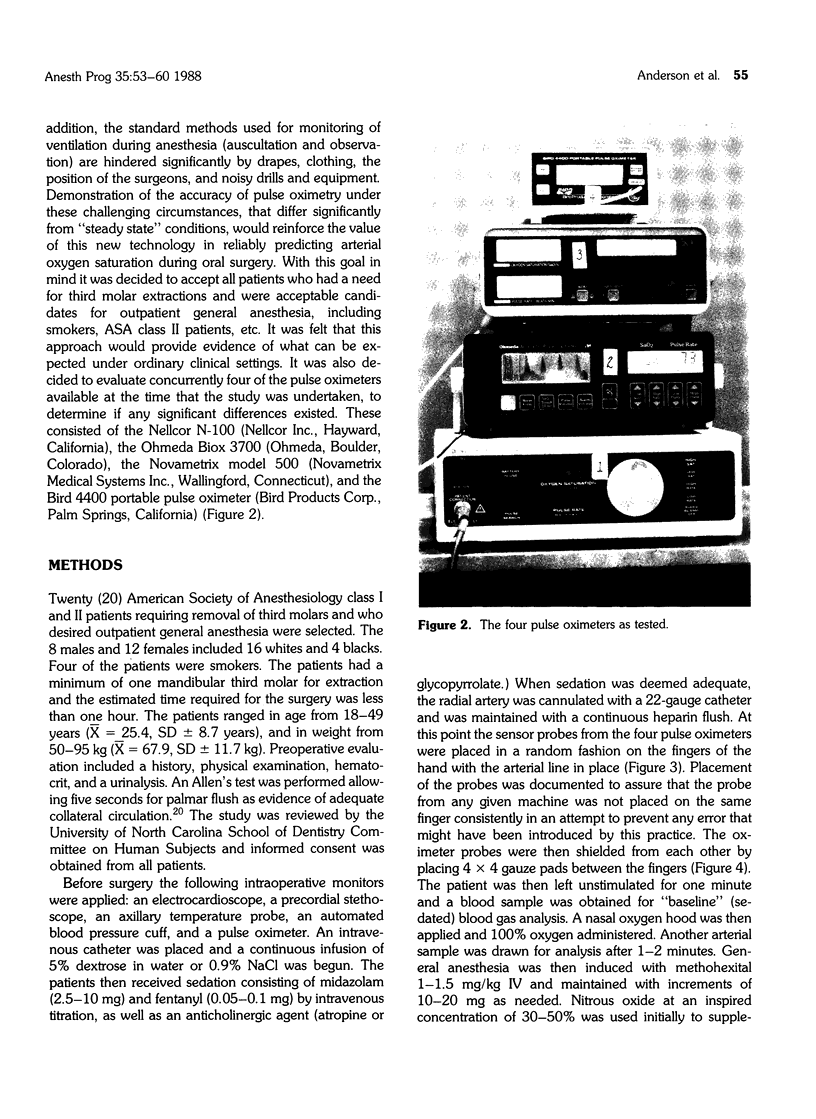
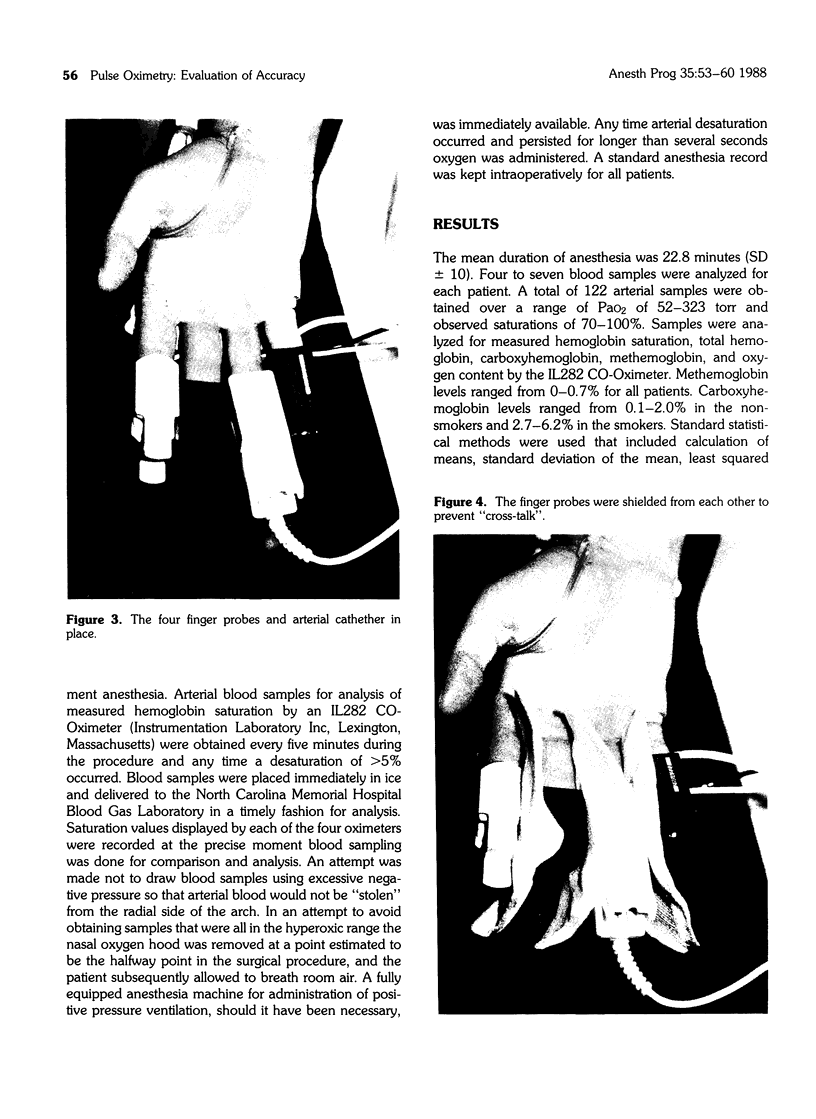
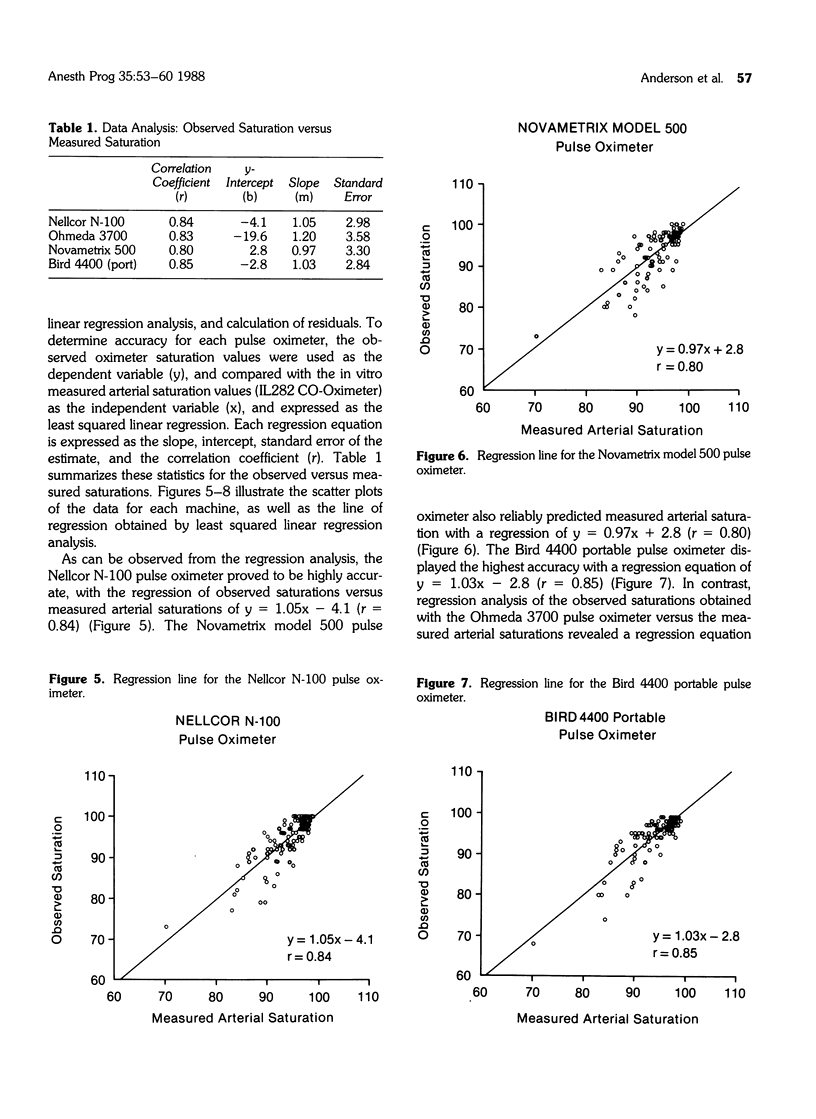
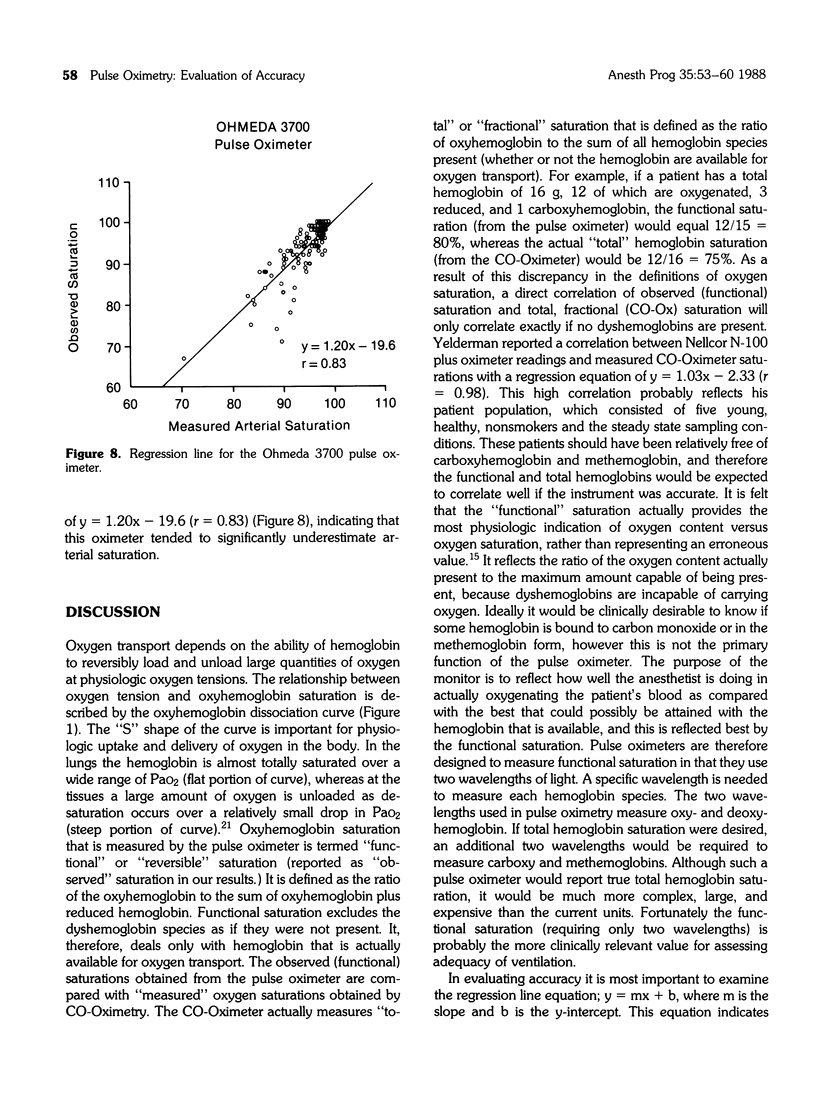
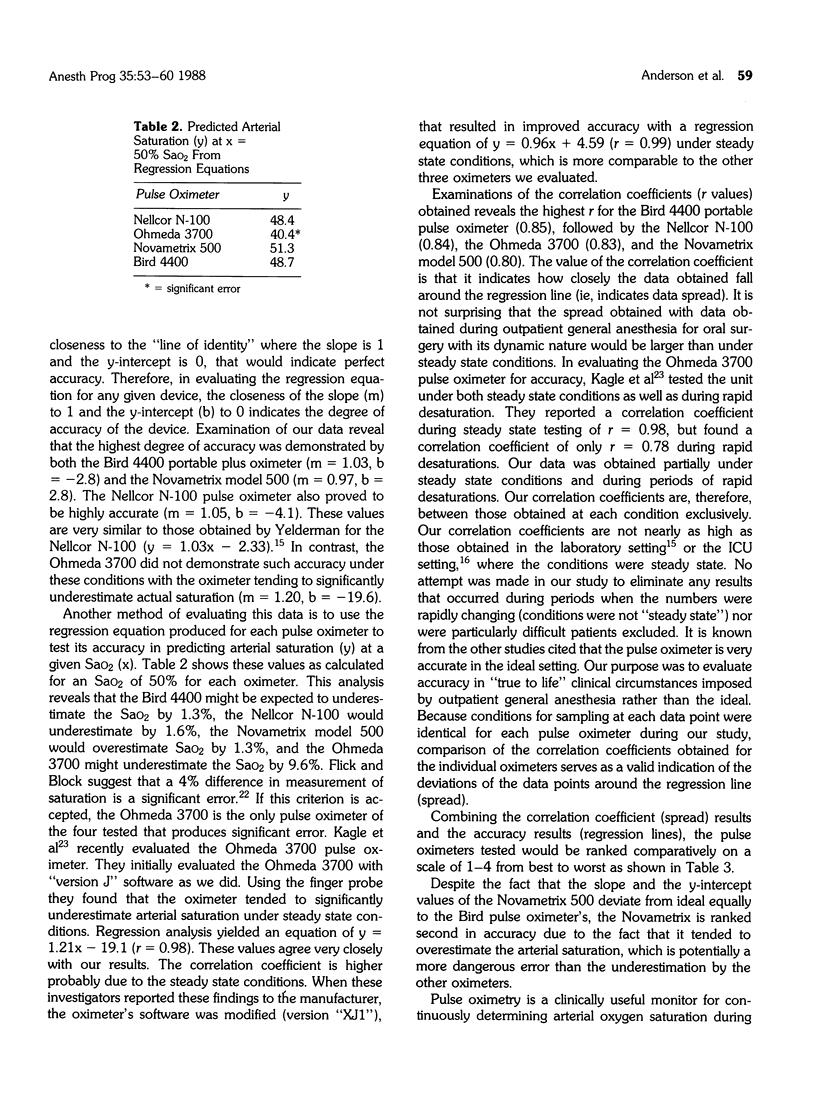
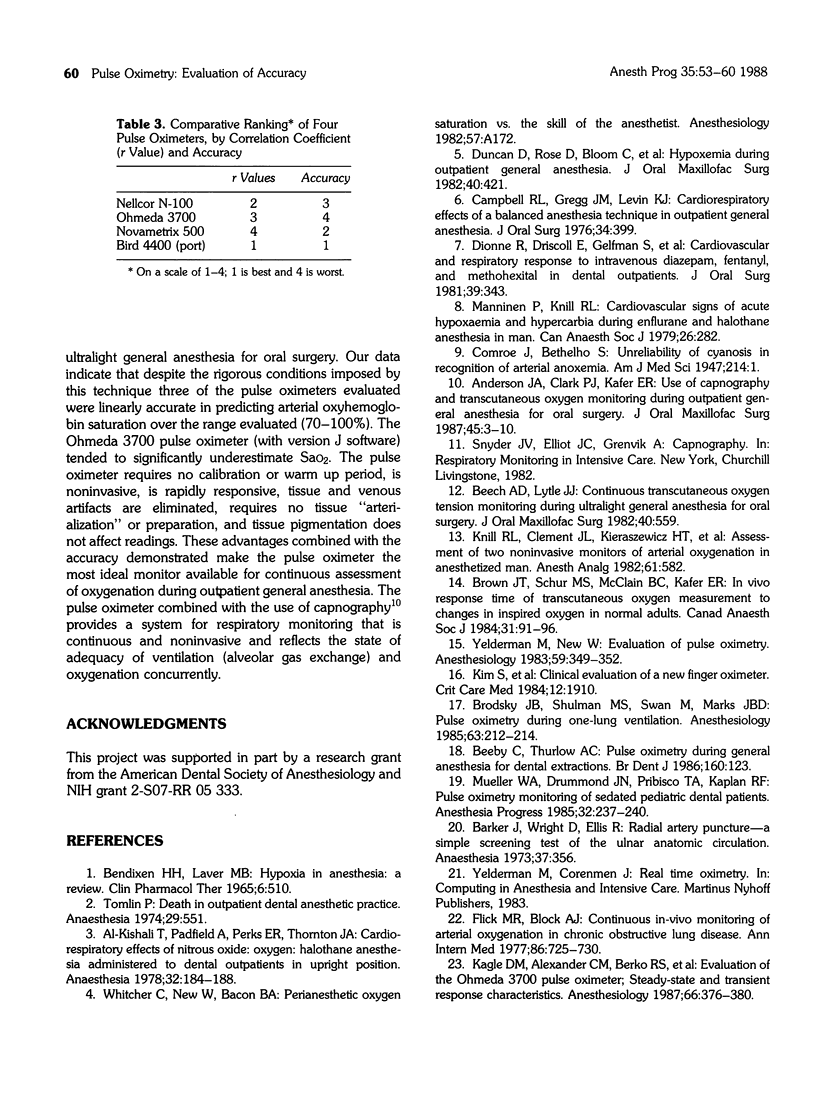
Images in this article
Selected References
These references are in PubMed. This may not be the complete list of references from this article.
- Al-Khishali T., Padfield A., Perks E. R., Thornton J. A. Cardio-respiratory effects of nitrous oxide:oxygen:halothane anaesthesia administered to dental outpatients in the upright position. Anaesthesia. 1978 Feb;33(2):184–188. doi: 10.1111/j.1365-2044.1978.tb08347.x. [DOI] [PubMed] [Google Scholar]
- Anderson J. A., Clark P. J., Kafer E. R. Use of capnography and transcutaneous oxygen monitoring during outpatient general anesthesia for oral surgery. J Oral Maxillofac Surg. 1987 Jan;45(1):3–10. doi: 10.1016/0278-2391(87)90078-4. [DOI] [PubMed] [Google Scholar]
- BENDIXEN H. H., LAVER M. B. HYPOXIA IN ANESTHESIA: A REVIEW. Clin Pharmacol Ther. 1965 Jul-Aug;6:510–539. doi: 10.1002/cpt196564510. [DOI] [PubMed] [Google Scholar]
- Beeby C., Thurlow A. C. Pulse oximetry during general anaesthesia for dental extractions. Br Dent J. 1986 Feb 22;160(4):123–125. doi: 10.1038/sj.bdj.4805787. [DOI] [PubMed] [Google Scholar]
- Beech A. D., Lytle J. J. Continuous transcutaneous oxygen tension monitoring during ultralight general anesthesia for oral surgery. J Oral Maxillofac Surg. 1982 Sep;40(9):559–565. doi: 10.1016/0278-2391(82)90283-x. [DOI] [PubMed] [Google Scholar]
- Brodsky J. B., Shulman M. S., Swan M., Mark J. B. Pulse oximetry during one-lung ventilation. Anesthesiology. 1985 Aug;63(2):212–214. doi: 10.1097/00000542-198508000-00021. [DOI] [PubMed] [Google Scholar]
- Brown J. T., Schur M. S., McClain B. C., Kafer E. R. In vivo response time of transcutaneous oxygen measurement to changes in inspired oxygen in normal adults. Can Anaesth Soc J. 1984 Jan;31(1):91–96. doi: 10.1007/BF03011489. [DOI] [PubMed] [Google Scholar]
- Campbell R. L., Gregg J. M., Levin K. J. Cardiorespiratory effects of a balanced anesthetic technique in outpatient general anesthesia. J Oral Surg. 1976 May;34(5):399–406. [PubMed] [Google Scholar]
- Dionne R. A., Driscoll E. J., Gelfman S. S., Sweet J. B., Butler D. P., Wirdzek P. R. Cardiovascular and respiratory response to intravenous diazepam, fentanyl, and methohexital in dental outpatients. J Oral Surg. 1981 May;39(5):343–349. [PubMed] [Google Scholar]
- Duncan D., Rose D., Bloom C., Hasse C., Poidmore S., Carlson R. Hypoxemia during outpatient general anesthesia. J Oral Maxillofac Surg. 1982 Jul;40(7):421–423. doi: 10.1016/0278-2391(82)90077-5. [DOI] [PubMed] [Google Scholar]
- Flick M. R., Block A. J. Continuous in-vivo monitoring of arterial oxygenation in chronic obstructive lung disease. Ann Intern Med. 1977 Jun;86(6):725–730. doi: 10.7326/0003-4819-86-6-725. [DOI] [PubMed] [Google Scholar]
- Kagle D. M., Alexander C. M., Berko R. S., Giuffre M., Gross J. B. Evaluation of the Ohmeda 3700 pulse oximeter: steady-state and transient response characteristics. Anesthesiology. 1987 Mar;66(3):376–380. doi: 10.1097/00000542-198703000-00018. [DOI] [PubMed] [Google Scholar]
- Knill R. L., Clement J. L., Kieraszewicz H. T., Dodgson B. G. Assessment of two noninvasive monitors of arterial oxygenation in anesthetized man. Anesth Analg. 1982 Jul;61(7):582–586. [PubMed] [Google Scholar]
- Manninen P., Knill R. L. Cardiovascular signs of acute hypoxaemia and hypercarbia during enflurane and halothane anaesthesia in man. Can Anaesth Soc J. 1979 Jul;26(4):282–287. doi: 10.1007/BF03006288. [DOI] [PubMed] [Google Scholar]
- Mueller W. A., Drummond J. N., Pribisco T. A., Kaplan R. F. Pulse oximetry monitoring of sedated pediatric dental patients. Anesth Prog. 1985 Nov-Dec;32(6):237–240. [PMC free article] [PubMed] [Google Scholar]
- Tomlin P. J. Death in outpatient dental anaesthetic practice. Anaesthesia. 1974 Sep;29(5):551–570. doi: 10.1111/j.1365-2044.1974.tb00718.x. [DOI] [PubMed] [Google Scholar]
- Yelderman M., New W., Jr Evaluation of pulse oximetry. Anesthesiology. 1983 Oct;59(4):349–352. doi: 10.1097/00000542-198310000-00015. [DOI] [PubMed] [Google Scholar]



